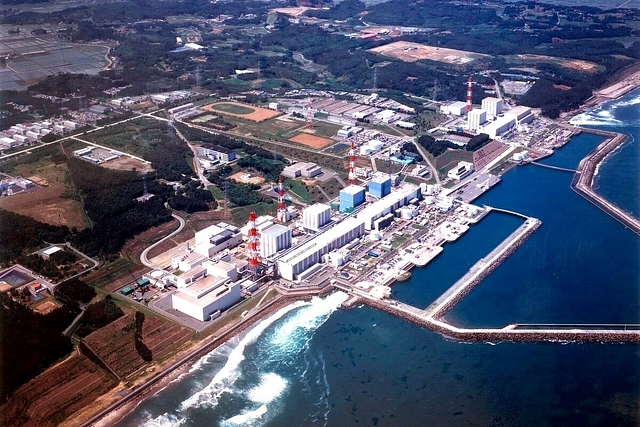World
Explained: Japan Releasing Radioactive Wastewater Into Sea From Fukushima Nuclear Plant
- Since the 2011 tsunami devastated the facility, 1.34 million tonne water — enough to fill 500 Olympic-size pools — has accumulated.
- After being filtered and diluted, the water will be released over a 30-year period.

Fukushima Daiichi Nuclear Power Plant (Wikipedia)
Despite resistance from its neighbours, Japan will begin discharging diluted radioactive water from the tsunami-hit Fukushima Daiichi nuclear plant into the Pacific Ocean on Thursday (24 August).
The decision comes weeks after the plan was approved by the United Nations's nuclear watchdog-International Atomic Energy Agency (IAEA).
According to the Japan government, releasing the water is an essential step in the lengthy and costly process of decommissioning the plant, which is located on the country's east coast, roughly 220 kilometre (137 miles) north-east of Tokyo.
The UN's nuclear watchdog approved it in July, with authorities deciding that the impact on people and the environment would be insignificant.
Why release? Space Constraints and Storage Challenges
The stage for this decision was set years ago when authorities warned in 2019 that storage space for the accumulating wastewater was dwindling rapidly, leaving Japan with "no other options" but to resort to release.
In the aftermath of the devastating 2011 earthquake and tsunami, the Fukushima nuclear plant faced critical damage to its power supply and cooling systems.
The resulting overheating of reactor cores contaminated the plant's water with highly radioactive material. Since then, a constant influx of new water has been necessary to cool the fuel debris, leading to the gradual accumulation of radioactive wastewater.
Since the 2011 tsunami devastated the facility, 1.34 million tonne of water — enough to fill 500 Olympic-size pools — have accumulated.
Rainwater and groundwater infiltration further contributed to this growing issue, necessitating the need for storage and treatment solutions.
To address the storage challenge, Tokyo Electric Power Co. (TEPCO) erected massive tanks to contain the radioactive wastewater. However, the space within these tanks is fast running out. TEPCO argued that constructing more tanks wasn't a feasible option, as they need to clear space for the safe decommissioning of the Fukushima plant.
This pressing need for space prompted Japan to explore various alternatives.
Options Considered: From Vapor Release to Controlled Ocean Discharge
Japan weighed five potential options for dealing with the radioactive wastewater, including the unconventional vapour release method, which involved boiling the wastewater and releasing it into the atmosphere.
However, most of these alternatives were deemed "industrially immature" by the IAEA Director General Rafael Grossi.
Vapor release was particularly challenging due to the unpredictability of environmental factors such as wind and rain that could redirect the waste back to Earth.
This left controlled release into the ocean as the chosen route, a practice already employed by nuclear plants worldwide.
The Tritium Debate
Central to the controversy is the presence of radioactive tritium, an isotope of hydrogen, in the wastewater.
TEPCO, Japan's government, and the IAEA assert that tritium occurs naturally in the environment, including rain and tap water, making the wastewater's slow release over decades relatively safe.
However, some scientists voice concerns about potential harm to marine life and ecosystem vulnerability.
The absence of conclusive data on the long-term biological effects of tritium exposure adds complexity to the debate.
Addressing Concerns: Dilution and Third-Party Monitoring
After being filtered and diluted, the water will be released over a 30-year period.
The wastewater will undergo rigorous treatment to significantly reduce its radioactive material concentrations.
By heavily diluting it with clean water, the aim is to minimize potential environmental impact. Furthermore, third-party organizations, including the IAEA, will closely monitor the entire process.
The IAEA, with a presence at a newly opened office in Fukushima, is poised to oversee the situation for an extended period, ensuring compliance with safety measures.
Global Reactions: Divergent Views
The global response to Japan's plan has been a mix of support and skepticism. The United States and Taiwan have lent their backing, deeming the tritium release as having "minimal" impact.
While South Korean leaders have overwhelmingly supported the idea, opposition lawmakers have expressed concern, and demonstrators have demanded that it be scrapped.
Conversely, China and the Pacific Islands have taken a firm stand against it, highlighting fears of broader regional and international consequences, including threats to human health and marine ecosystems.
Hong Kong said it would "immediately activate" import restrictions on certain Japanese foods.
South Korea and China have already prohibited imports of fish from the Fukushima area.
Support Swarajya's 50 Ground Reports Project & Sponsor A Story
Every general election Swarajya does a 50 ground reports project.
Aimed only at serious readers and those who appreciate the nuances of political undercurrents, the project provides a sense of India's electoral landscape. As you know, these reports are produced after considerable investment of travel, time and effort on the ground.
This time too we've kicked off the project in style and have covered over 30 constituencies already. If you're someone who appreciates such work and have enjoyed our coverage please consider sponsoring a ground report for just Rs 2999 to Rs 19,999 - it goes a long way in helping us produce more quality reportage.
You can also back this project by becoming a subscriber for as little as Rs 999 - so do click on this links and choose a plan that suits you and back us.
Click below to contribute.
Latest